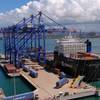Slight Growth in Port of Hamburg’s Seaborne Cargo Handling
At 32.8 million tons, total seaborne cargo throughput for the first three months of 2013 put the Port of Hamburg back on a growth course.
The trend in bulk cargo handling, especially, fuelled the increase in seaborne cargo handling: In the first quarter of the year a total of 10.1 million tons of bulk cargoes were handled in Hamburg, corresponding to an increase of 6.3 percent. At 2.2 million TEU (20-ft standard containers), the container handling that dominates in Hamburg as a universal port reached almost the same level as in the first quarter of 2012.
On seaborne container services with Asia, at 1.2 million TEU almost as many boxes were handled in the first quarter of 2013 as in the comparable period of last year. In the first three months of the year, the trend in container throughput with the Baltic region and the other European countries linked with Hamburg by feeders was also positive. At 541,000 TEU, the volume of containers transported between the Port of Hamburg and the Baltic region was up by 2.0 percent on the same period of last year.
Large quantities of cargoes in foreign trade to and from overseas are handled by feeders on transhipment services via Hamburg. In this segment, Hamburg constitutes a significant world trade hub for the European market. The Baltic region, especially, is served by transhipment services via the Port of Hamburg. The port’s main trading partner in the Baltic region is Russia, accounting for 161,000 TEU in the first quarter of 2013. With around 155 sailings per week, Hamburg offers the densest network in Northern Europe of feeder connections into the entire Baltic region. “In combination with this positive trend in feeder traffic, during the rest of the year we anticipate slight growth for container liner services as well,” said a confident Claudia Roller, CEO of Port of Hamburg Marketing.
General cargo throughput at 22.7 million tons, or 1.7 percent lower, remained just below the first-quarter total in 2012. Similarly, containerized general cargo throughput at 22.3 million tons was down by 1.4 percent, i.e., just below last year’s figure. Handling of conventional general cargo at 435,000 tons also failed to match the previous year’s total by 17.5 percent.
In the first quarter of 2013 bulk cargo throughput was well above last year’s, rising by 6.3 percent to a total of 10.1 million tons. Growth was reported from all three segments, namely grab, suction and liquid cargoes. Grab cargo throughput in the first three months reached 4.9 million tons, representing a gain of 2.7 percent on the same period of 2012. Mainly responsible for growth in this segment were imports of ore and coal. Fertilizers, especially, generated first-quarter growth in exports of grab cargo. At 3.3 million tons, throughput of liquid cargoes in the first quarter of 2013 was up by 6.1 percent. Here the long winter caused larger import volumes of oil products, which at 1.3 million tons in the first quarter of 2013 were 30.4 percent higher than in the previous year. At 1.8 million tons, handling of suction cargoes in the first of quarter 2013 was up by 18.2 percent. Decisive here were export volumes, increasing by 44.5 percent to 921,000 tons. At 654,000 tons, grain exports grew by no less than 68.7 percent. While grain imports in the first quarter of 2013 also rose, volume here did not suffice to offset the decline in imports of oleaginous fruits and other suction cargoes, so that total imports of suction cargoes at 869,000 tons were 0.9 percent lower.
The German economy is primarily sustained by domestic consumption plus exports. An increase in orders received by manufacturing industry in the first three months of the year encourages expectations of an upturn for the economy in 2013 that should have a positive effect on cargo volume via the Port of Hamburg. If the port is to be prepared for further growth, however, the deepening of the navigation channel on the Lower and Outer Elbe will be of the utmost importance.












